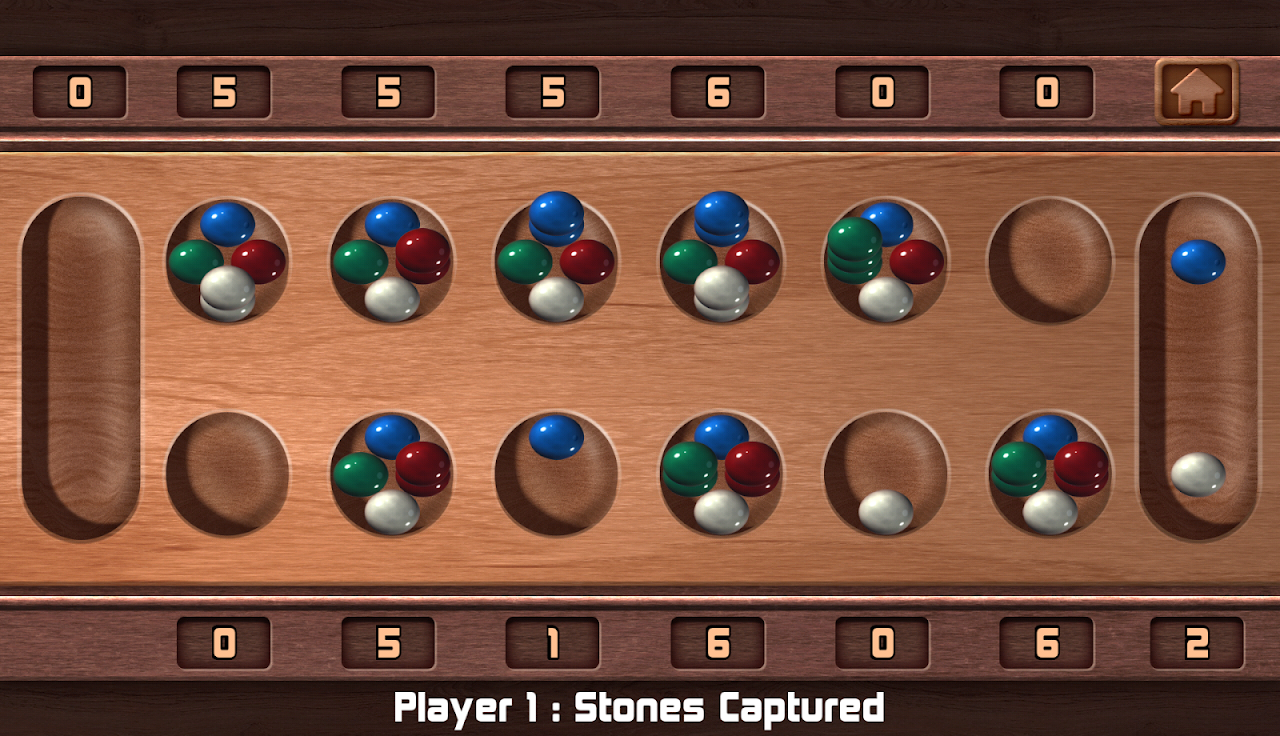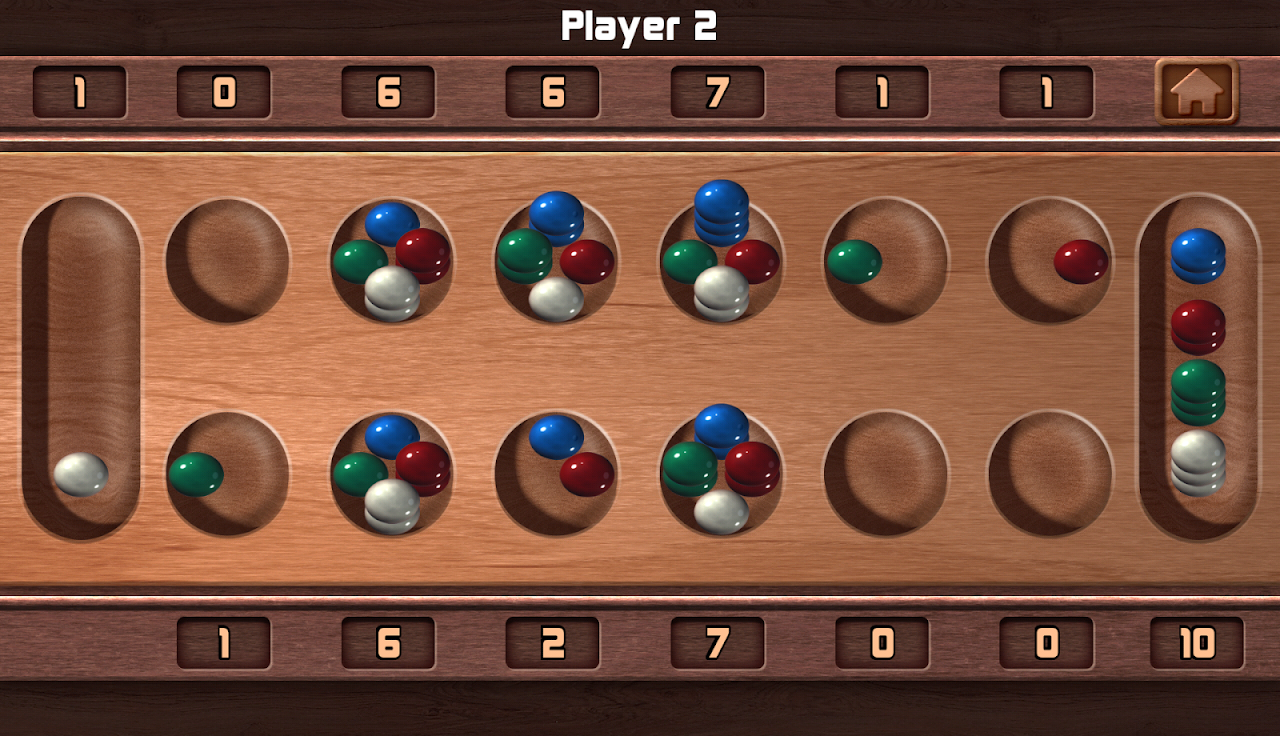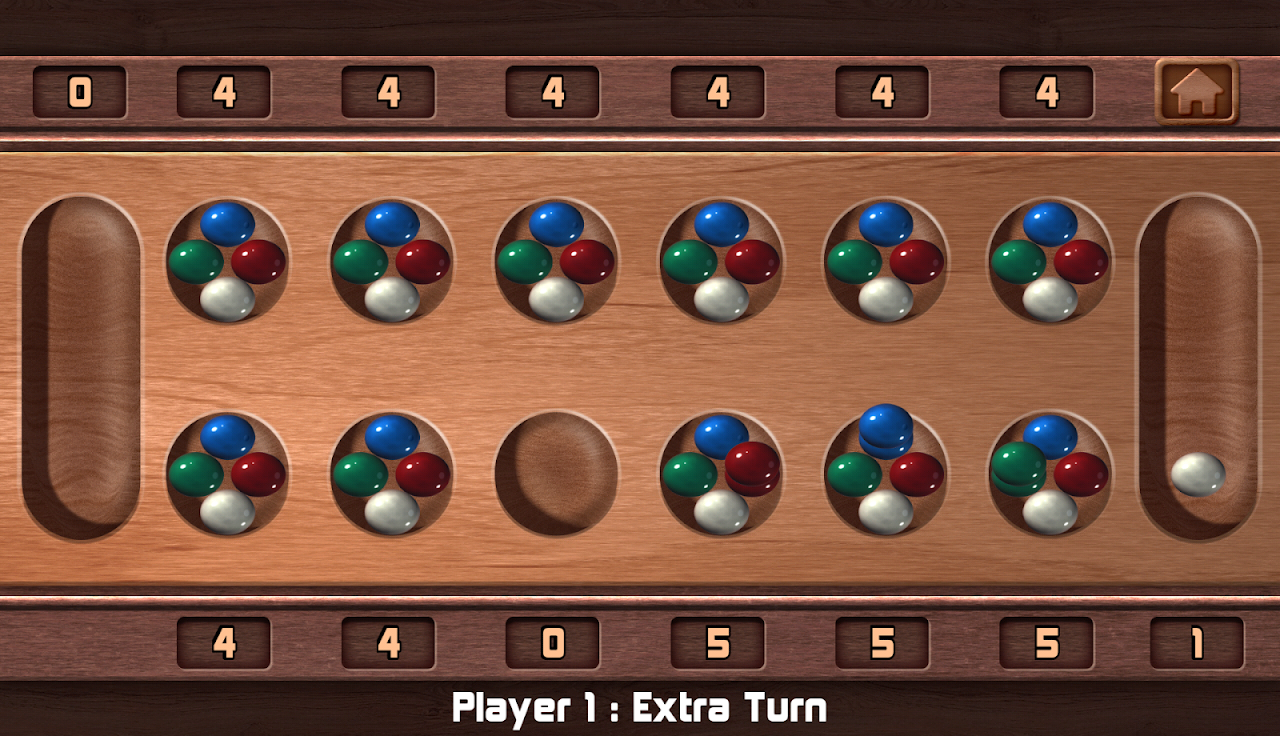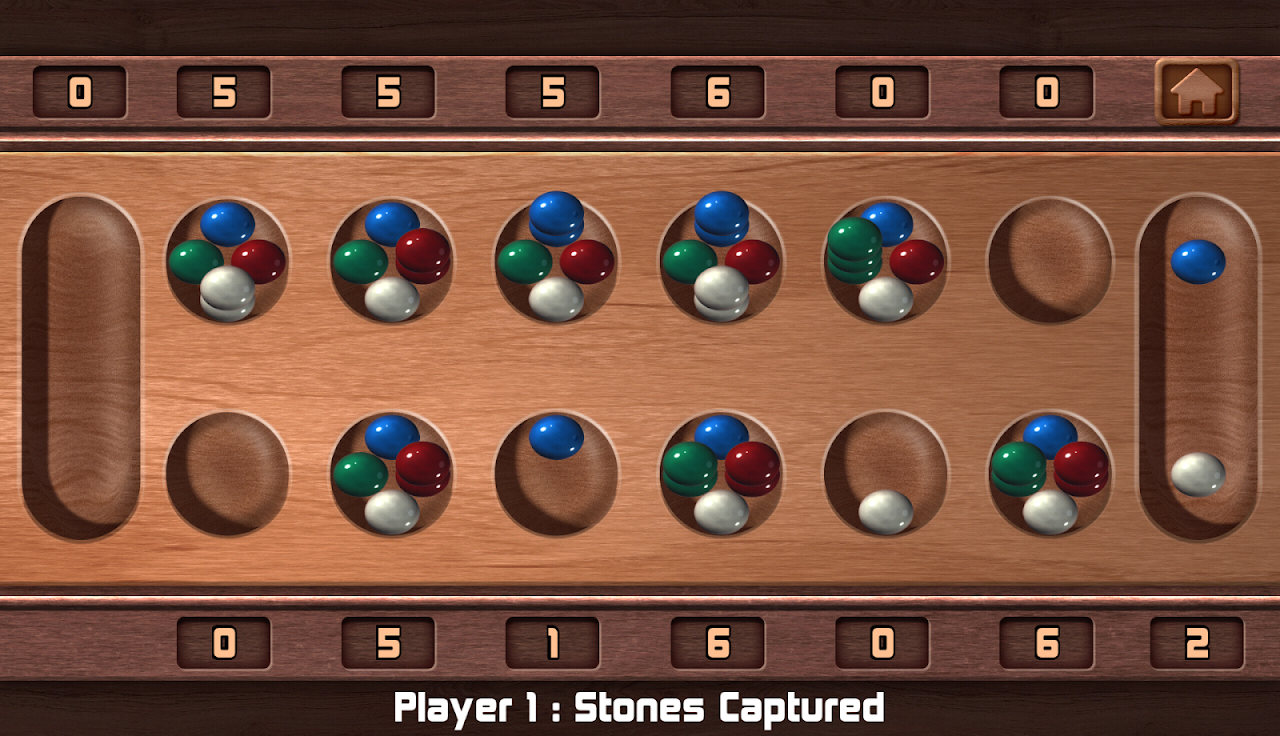HOW TO PLAY THE MANCALA FREE APP?
GAME SET-UP:
The board has two rows, six pits (round holes) each with a store (oblong hole) at each end. Four marbles are placed in each hole.
MANCALA GAMEPLAY:
Each player starts their turn by selecting a hole on their side. The player drops a marble, one-by-one, into each succeeding hole counter-clockwise around the board until the marbles run out. In Mancala, this is called "sowing."
CAPTURE: If you end on an empty pit in your row, the marbles in the opposite pit are captured.
FREE TURNS: Place your LAST MARBLE in your store and get an extra turn!
AND THE WINNER IS...
When a player runs out of marbles, the game ends. The opponent gets to add all marbles on their side of the board to their store. This is where real strategy comes into play.
The player with the most marbles in their store wins!
MANCALA FREE STRATEGY TIPS
- Plan ahead, get free turns whenever possible.
- Going first? Start with the hole that is FOUR PITS away from your store. Why? Because the last marble you place will end in your store and you get a BONUS turn!
Ready to travel back in time? Mancala isn't exactly a time machine, but it's one of civilization's earliest games.
Mancala, an ancient game of strategy and skill, has been played for centuries across cultures and continents. With simple rules yet challenging gameplay, Mancala captivates players of all ages.
Gameplay:
Mancala is played on a board with two rows of six pits each, plus two larger pits called mancalas, one for each player. Each pit initially contains four seeds, beans, or other small objects.
The goal of the game is to capture more seeds than your opponent by moving seeds around the board. Players take turns, and on their turn, they choose a pit on their side of the board and sow its seeds counterclockwise into the subsequent pits.
If the last seed sown lands in your mancala, you get an extra turn. If the last seed lands in an empty pit on your side of the board, you capture all the seeds in the opposite pit and place them in your mancala.
Capturing Seeds:
Capturing seeds is crucial in Mancala. If the last seed sown lands in an empty pit on your side of the board, you capture all the seeds in the opposite pit and place them in your mancala. This rule allows for strategic blocking and planning.
Blocking and Planning:
Blocking your opponent from capturing seeds and planning your moves to maximize your captures are essential strategies in Mancala. By thinking ahead and anticipating your opponent's moves, you can gain an advantage and increase your chances of winning.
Winning:
The game ends when all the seeds have been captured. The player with the most seeds in their mancala wins. In some variations, the player who captures all their opponent's seeds wins instantly.
Variations:
Mancala has numerous variations with different board sizes, starting seed counts, and capture rules. Some popular variations include:
* Kalah: Played on a board with six pits on each side and a starting count of six seeds per pit.
* Bao: Played on a board with eight pits on each side and a starting count of four seeds per pit.
* Oware: Played on a board with six pits on each side and a starting count of four seeds per pit.
Conclusion:
Mancala is a timeless game that combines strategy, skill, and a touch of luck. With its simple rules, engaging gameplay, and numerous variations, Mancala has captivated players for generations. Whether you're a seasoned player or a curious newcomer, Mancala offers a rewarding and enjoyable experience.
HOW TO PLAY THE MANCALA FREE APP?
GAME SET-UP:
The board has two rows, six pits (round holes) each with a store (oblong hole) at each end. Four marbles are placed in each hole.
MANCALA GAMEPLAY:
Each player starts their turn by selecting a hole on their side. The player drops a marble, one-by-one, into each succeeding hole counter-clockwise around the board until the marbles run out. In Mancala, this is called "sowing."
CAPTURE: If you end on an empty pit in your row, the marbles in the opposite pit are captured.
FREE TURNS: Place your LAST MARBLE in your store and get an extra turn!
AND THE WINNER IS...
When a player runs out of marbles, the game ends. The opponent gets to add all marbles on their side of the board to their store. This is where real strategy comes into play.
The player with the most marbles in their store wins!
MANCALA FREE STRATEGY TIPS
- Plan ahead, get free turns whenever possible.
- Going first? Start with the hole that is FOUR PITS away from your store. Why? Because the last marble you place will end in your store and you get a BONUS turn!
Ready to travel back in time? Mancala isn't exactly a time machine, but it's one of civilization's earliest games.
Mancala, an ancient game of strategy and skill, has been played for centuries across cultures and continents. With simple rules yet challenging gameplay, Mancala captivates players of all ages.
Gameplay:
Mancala is played on a board with two rows of six pits each, plus two larger pits called mancalas, one for each player. Each pit initially contains four seeds, beans, or other small objects.
The goal of the game is to capture more seeds than your opponent by moving seeds around the board. Players take turns, and on their turn, they choose a pit on their side of the board and sow its seeds counterclockwise into the subsequent pits.
If the last seed sown lands in your mancala, you get an extra turn. If the last seed lands in an empty pit on your side of the board, you capture all the seeds in the opposite pit and place them in your mancala.
Capturing Seeds:
Capturing seeds is crucial in Mancala. If the last seed sown lands in an empty pit on your side of the board, you capture all the seeds in the opposite pit and place them in your mancala. This rule allows for strategic blocking and planning.
Blocking and Planning:
Blocking your opponent from capturing seeds and planning your moves to maximize your captures are essential strategies in Mancala. By thinking ahead and anticipating your opponent's moves, you can gain an advantage and increase your chances of winning.
Winning:
The game ends when all the seeds have been captured. The player with the most seeds in their mancala wins. In some variations, the player who captures all their opponent's seeds wins instantly.
Variations:
Mancala has numerous variations with different board sizes, starting seed counts, and capture rules. Some popular variations include:
* Kalah: Played on a board with six pits on each side and a starting count of six seeds per pit.
* Bao: Played on a board with eight pits on each side and a starting count of four seeds per pit.
* Oware: Played on a board with six pits on each side and a starting count of four seeds per pit.
Conclusion:
Mancala is a timeless game that combines strategy, skill, and a touch of luck. With its simple rules, engaging gameplay, and numerous variations, Mancala has captivated players for generations. Whether you're a seasoned player or a curious newcomer, Mancala offers a rewarding and enjoyable experience.












